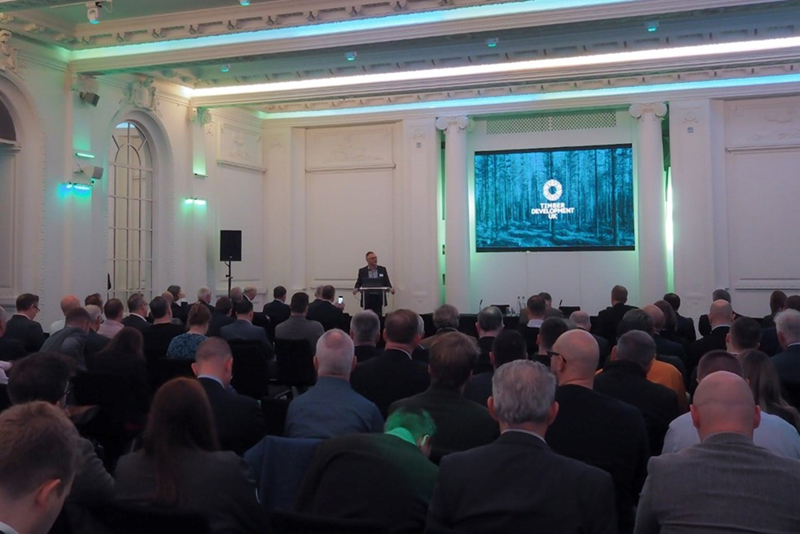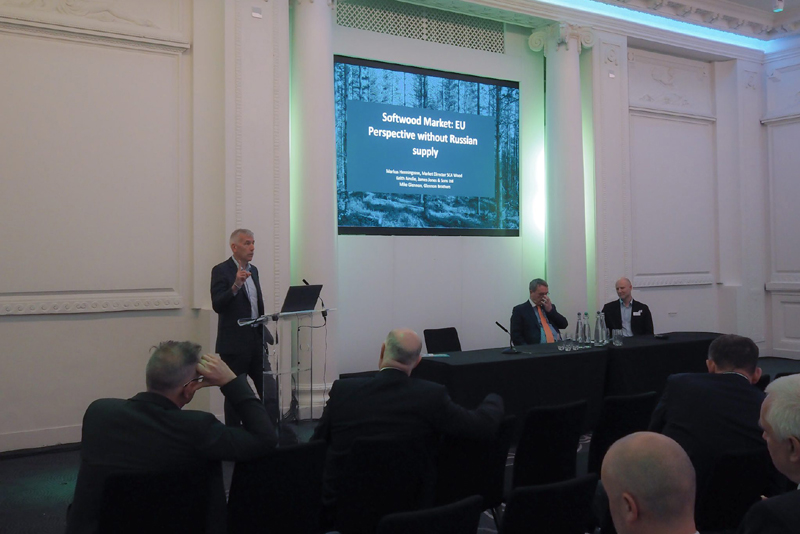
Despite the turbulent times, the long-term future for timber construction remains bright according to the speakers at the recent TDUK Global Market Conference.
More than 130 industry leaders came together in London on 2nd November to discuss the state of the timber sector at Timber Development UK’s (TDUK) Global Market Conference. And while numerous speakers warned of stormy weather ahead amidst gloomy economic projections for 2023, they also said that brighter days would follow, with the industry poised for major growth considering timber’s status as a key low-carbon solution.
Attendees were welcomed by TDUK Chief Executive David Hopkins, who began proceedings by reiterating the recent merger between the Timber Trade Federation and TRADA to become Timber Development UK. He said: “TDUK has been formed to better reflect the reality of the market. Most of our members sell more than just one set of timber products to their customers, so we want to bring everyone together and get a better sense of what is happening right across the timber market.
“TDUK will lead best practice with the industry’s most comprehensive technical resource library. We’ll also give you the tool and guidance to lead the timber sector towards a low-carbon future, which now has to be central to the way we all do business.”
This was followed by a presentation on the current state of the timber supply trade from TDUK Head of Technical and Trade, Nick Boulton. Nick outlined the way volumes of timber imports into the UK have fluctuated over recent years, both during and immediately after the Covid pandemic.
He explained: “By the end of 2021, shortages of other materials encouraged people to delay work and so demand for timber fell, resulting in ports being full of unneeded timber stock. That’s part of the reason why, in the first six months of 2022, volumes of imports decreased while the backlog at the ports cleared.
“But in recent months, loss of consumer confidence has become the main cause of reduced demand for timber, and other building materials, in the domestic RMI market. We did see growth in the market during Q1 of 2022, which continued until June before starting to fall in line with decreasing consumer confidence, exaggerating the usual summer slowdown in the softwood market.”

Despite these fluctuations in timber imports, Nick said supplies to the construction sector during 2022 have been consistent and reliable with no shortage reported. He also addressed the fluctuation in timber pricing that has been seen over recent years, and particularly during the Covid pandemic, when demand for timber outstripped available supplies.
For instance, the TDUK Structural Importing Price Index highlights that, pre-Covid, the price of timber remained relatively stable for many years, and Nick predicted that in time the market will return to more stable pricing, albeit likely at a higher average price point than previously.
The challenging task of predicting what lies ahead for timber and the wider construction industry fell to Professor Noble Francis, Economics Director at the Construction Products Association (CPA).
Noble began by acknowledging how difficult it currently is to forecast accurately for 2023 considering the recent political and financial chaos, simply noting that “No-one knows what’s definitely going to happen, and there’s real uncertainty around the 2023/24 forecasts.”
He explained that UK GDP got back to pre-Covid levels at the start of 2022, however economists were expecting it to fall during both Q3 and Q4 this year, putting the UK into recession. Noble believes there will be further contraction at the start of 2023, but that the recovery will begin during the second half of next year, and that interest rates will peak somewhere around 4% in 2023.
While the UK entering recession with a forecast 1% fall of GDP next year is not a positive step, Noble reassured the gathered delegates that these falls are not as catastrophic as the economy saw during the crash of 2008, when GDP fell by 5%.
He also pointed out that construction was at a very high level during 2020 and 2021 due to all the domestic RMI work carried out during Covid, and so the decline in construction is from these high points — and he expects construction to begin its recovery in 2024.

For timber in particular, Noble echoed David’s assertion that the long-term future is bright. He said: “If the government wants to build 300,000 homes a year, as well as decarbonising the heat network, that means we will need to build more energy efficient homes and carry out lots of energy efficient retrofit work on existing buildings — all of that is good news for timber.”
Concluding the conference, David added: “The last couple of years have thrown some considerable challenges at our industry, with the pandemic, invasion of Ukraine and political instability placing the market on a rollercoaster, where highs are to be matched by lows. This coming winter looks no easier with energy security likely to be a key concern for businesses and households across Europe, as spiking interest rates, inflation, and labour availability create a challenging business environment.
“However, against this gloomy outlook, there is room for optimism on a policy level, with our speakers outlining the increasing recognition of timber as a climate change solution for the built environment. Through TDUK we are creating an opportunity to significantly advance timber’s position in the market, as we build strong connections between suppliers and specifiers.”
Click here for more information on Timber Development UK.
A version of this article first appeared in the December edition of PBM. See the following link to read the full digital issue online, via the PBM website.









